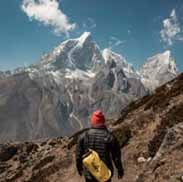Miller and Levine Biology Chapter 4 Vocabulary – Flashcards
Unlock all answers in this set
Unlock answersquestion
weather
answer
day-to-day condition of the atmosphere, including temperature, precipitation, and other factors
question
climate
answer
average year-to-year conditions of temperature and precipitation in an area over a long period of time
question
microclimate
answer
environmental conditions within a small area that differs significantly from the climate of the surrounding area
question
greenhouse effect
answer
process in which certain gases trap sunlight energy in Earth's atmosphere as heat
question
tolerance
answer
ability of an organism to survive and reproduce under circumstances that differ from their optimal conditions
question
habitat
answer
area where an organism lives, including the biotic and abiotic factors that affect it
question
niche
answer
full range of physical and biological conditions in which an organism lives and the way in which the organism uses those conditions
question
resource
answer
any necessity of life, such as water, nutrients, light, food, or space
question
competitive exclusion principle
answer
principle that states that no two species can occupy the same niche in the same habitat at the same time
question
predation
answer
interaction in which one organism captures and feeds on another organism
question
herbivory
answer
interaction in which one animal feeds on producers
question
keystone species
answer
single species that is not usually abundant in a community yet exerts strong control on the structure of a community
question
symbiosis
answer
relationship in which two species live close together
question
mutualism
answer
symbiotic relationship in which both species benefit from the relationship
question
parasitism
answer
symbiotic relationship in which one organism lives on or in another organism and harms it
question
commensalism
answer
symbiotic relationship in which one organism benefits and the other is neither helped nor harmed
question
ecological succession
answer
series of gradual changes that occur in a community following a disturbance
question
primary succession
answer
succession that occurs in an area in which no trace of a previous community is present
question
pioneer species
answer
first species to populate an area during succession
question
secondary succession
answer
type of succession that occurs in an area that was only partially destroyed by disturbances
question
canopy
answer
dense covering formed by the leafy tops of tall forest trees
question
understory
answer
layer in a forest found underneath the canopy formed by shorter trees and vines
question
deciduous
answer
term used to refer to a type of tree that sheds its leaves during a particular season each year
question
coniferous
answer
term used to refer to trees that produce seed-bearing cones and have thin leaves shaped like needles
question
humus
answer
material formed from decaying leaves and other organic matter
question
taiga
answer
biome with long cold winters and a few months of warm weather; dominated by coniferous evergreens; also called boreal forest
question
permafrost
answer
layer of permanently frozen subsoil found in the tundra
question
photic zone
answer
sunlight region near the surface of the water
question
aphotic zone
answer
dark layer of the oceans below the photic zone where light does not penetrate
question
benthos
answer
organisms that live attached to or near the bottom of lakes, streams, and oceans
question
plankton
answer
microscopic organisms that live in aquatic environments, includes both phytoplankton and zooplankton
question
wetland
answer
ecosystem in which water either covers the soil or is present at or neat the surface for at least part of the year
question
estuary
answer
kind of wetland formed where a river meets the ocean
question
tropical rain forest biome
answer
biome characterized by large amounts of rainfall, thick canopies and understories, little nutrients in the soil, and high biodiversity
question
tropical dry forest biome
answer
biome characterized by alternating rainy and dry seasons with rich soil that is subject to erosion
question
tropical grassland/savanna/shrubland biome
answer
warm seasonal rainfall on a landscape of grasses and shrubs with isolated trees. soils are compact and fires are frequent
question
desert biome
answer
very little rainfall with soils rich in minerals but poor in nutrients. temperature, elevation, and latitude can vary greatly
question
temperate grassland biome
answer
plains and prairies cover fertile soils. warm to hot summers with cold winters and moderate rainfall
question
temperate woodland and shrubland biome
answer
open woodlands with large areas of grasses and wildflowers and dense low plants. hot, dry summers with cool, moist winters
question
temperate forest biome
answer
made of a mix of deciduous and evergreen trees. fertile soils with rich humus layers. 4 seasons with warm summers and cold winters
question
northwest coniferous forest biome
answer
mild temperatures and abundant precipitation in the fall, winter, and spring with cool dry summers. also known as teh temperate rainforest
question
boreal forest biome
answer
dense forests of evergreens with very cold winters and short mild summers. also known as the taiga
question
tundra biome
answer
very short cold summers and very long and extremely cold winters with strong winds and little precipitation. contains permafrost
question
mountain ranges
answer
not classified with other biomes because the elevation on the mountain changes the weather as well as plants, animals, and soil
question
polar ice caps
answer
cold year round with very few plants. most animals live in the waters underneath ice
question
rivers and streams
answer
areas of flowing water often originating from underground sources in mountains or hills
question
lakes and ponds
answer
slow moving and confined water gives plants a chance to attach
question
freshwater wetlands
answer
water either covers soil or is present at or near the surface. filters chemicals and serves as a breeding ground for many animals
question
intertidal zone
answer
area that is submerged at high tide but exposed at low tide
question
coastal ocean
answer
shallow oceans that extend from the low tide mark to the outer edge of the continental shelf
question
open ocean
answer
deep oceans that extend between continental shelves. contains both photic and aphotic zones



